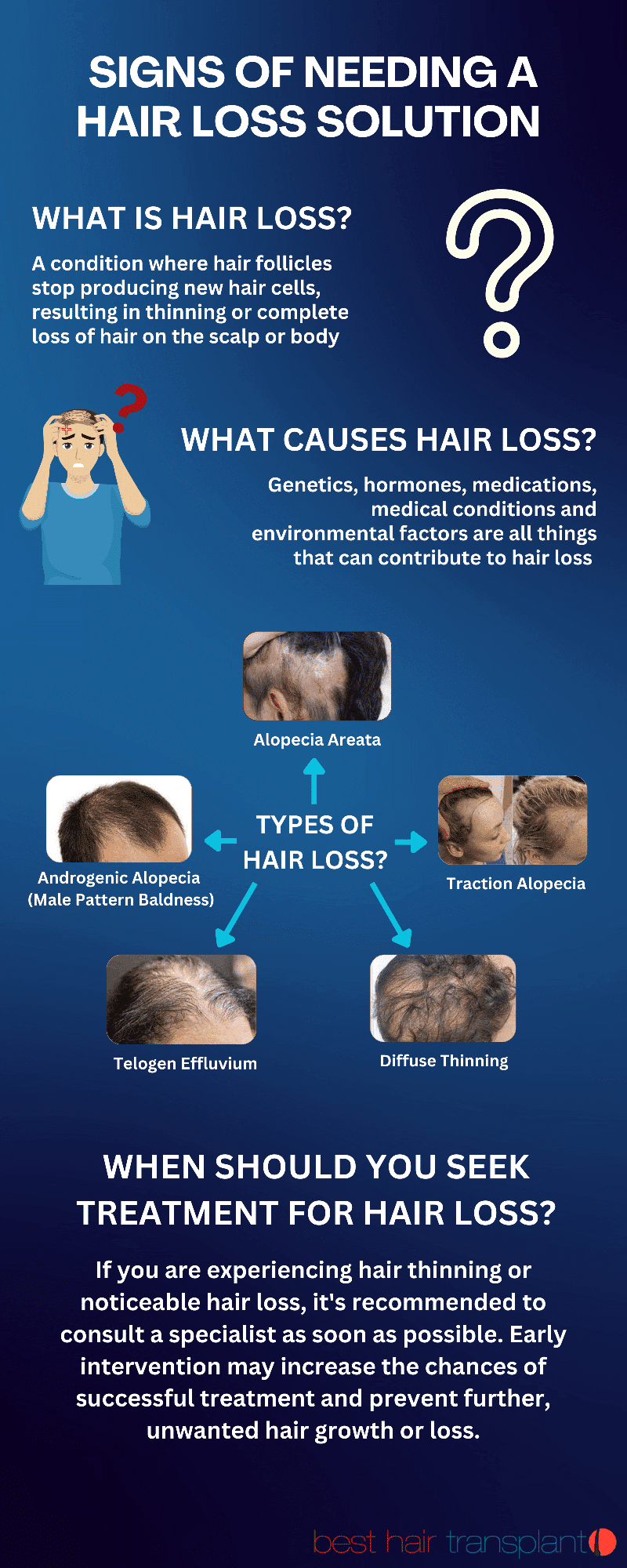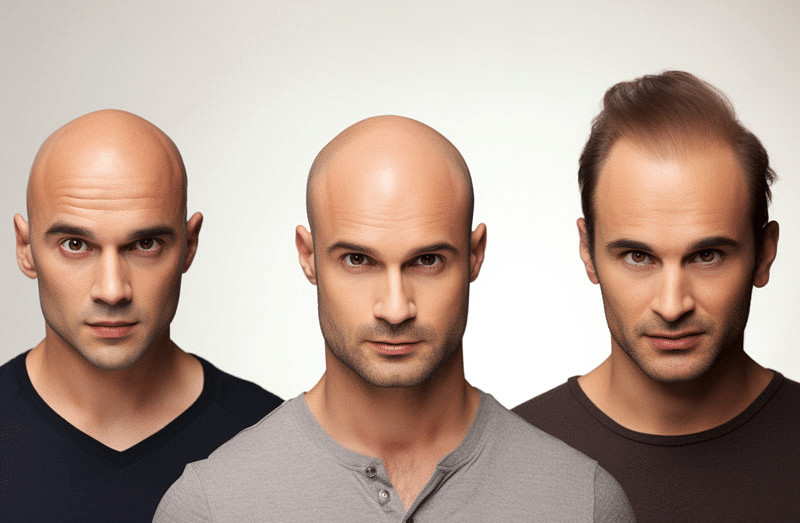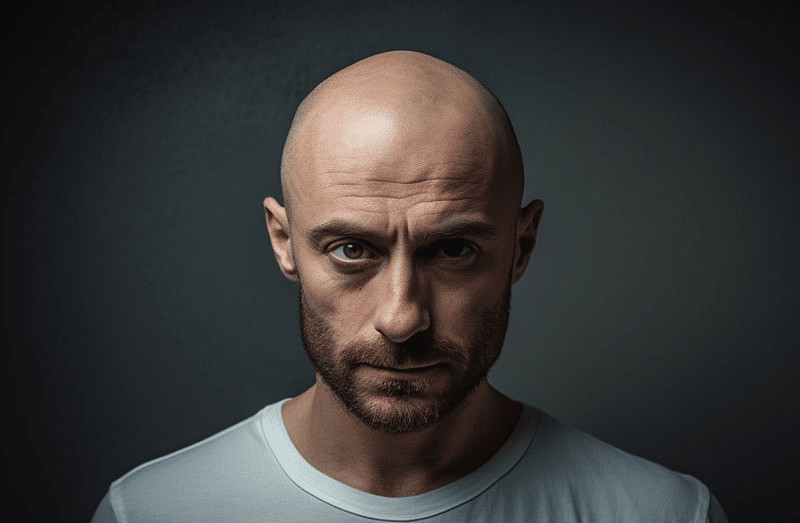Several signs indicate you may need a permanent hair loss solution, such as thinning hair, circular or patchy baldness, and a receding hairline. These signs can all be attributed to various factors, including genetics, age, hormonal changes, medical treatments and conditions, and even environmental factors.
Thinning hair is one of the most common signs of hair loss. As you age, you may notice that your hair is not regrowing or thickening as it used to, and more of your scalp becomes visible. Hair loss can also occur in circular or patchy patterns, which can be a sign of alopecia.
What is hair loss?
Hair to treat hair loss, is a condition that affects both men and women and can cause physical and mental hardships. It occurs when hair follicles stop producing new hair cells, resulting in thinning or complete loss of hair on the scalp or body. Various factors, including genetics, hormones, medical conditions, medications, and environmental factors can cause hair loss.
According to HIM’s, male pattern baldness is the most common type of hereditary hair loss. It is caused by an inherited sensitivity to DHT, or dihydrotestosterone. This hormone causes hair follicles to shrink over time, resulting in thinner and shorter strands of hair. On the other hand, female pattern baldness usually starts with thinning at the crown of the head and can be attributed to hormonal imbalances.
Hair loss can also occur in circular or patchy patterns, known as alopecia areata. This type of hair loss is an autoimmune disorder where the body’s immune system mistakenly attacks the hair follicles, causing them to stop producing new hair cells.
What are the types of hair loss?

There are several types and causes of hair loss everywhere, each with its own unique causes and characteristics. Androgenic Alopecia is the most common type is male pattern baldness seen today. It affects over 50% of men by the time they reach the age of 50, and sometimes, much younger than that. This type is caused by genetics and hormonal changes, specifically an increased sensitivity to dihydrotestosterone (DHT).
Female pattern baldness, on the other hand, is caused by hormonal imbalances and usually manifests as thinning hair at the crown of the head.
Alopecia areata is a type of hair loss characterized by circular or patchy bald spots. It is an autoimmune disorder where the body’s immune system mistakenly attacks the hair follicles, causing them to stop producing new hair cells.
Another type of hair loss is telogen effluvium, which occurs when a physical or emotional shock causes hair follicles to go into a resting phase, resulting in excessive shedding of hair. This can happen after giving birth, undergoing surgery, or experiencing significant stress.
There is traction alopecia, which is caused by repeated pulling on the hair, often due to tight hairstyles like braids or ponytails. Traction alopecia is most common in women of African descent and can lead to permanent hair loss if not addressed early on.
How common is hair loss?

Hair or slow hair loss, is a common condition that affects millions of people worldwide. In fact, it is estimated that around 50 million men and 30 million women in the United States alone experience some form of hair loss. As we age, the likelihood of experiencing hair loss increases, with approximately 85% of men over the age of 50 experiencing significant hair thinning.
While male pattern baldness is the most common type of hair loss, affecting over 50% of men by the age of 50, it is not exclusive to men. Women can also experience female pattern baldness, with around 40% of women showing signs of hair thinning by the age of 50.
Alopecia areata, while less common, still affects around 2% of the population at some point in their lives. This type of hair loss can occur at any age and can be triggered by various factors such as stress or illness.
What are the symptoms of hair loss?
Symptoms of hair loss vary depending on the type and severity of the condition. The most common symptom of hair falls is thinning hair, where the scalp becomes more visible as hair follicles stop producing new strands. This can happen all over the head or in specific areas, depending on the type of hair loss.
Another symptom is circular or patchy bald spots, which are often a sign of alopecia areata. This type of hair loss can also cause itching or burning sensations in the affected areas.
For some individuals, hair loss can also be accompanied by scalp tenderness or pain and even an increase in hair shedding while showering or brushing their hair.
In more severe cases, complete hair loss on the scalp irritation or body may occur, leading to complete baldness. This can be particularly distressing for both men and women, affecting their self-confidence and self-esteem.
If you are experiencing any of these symptoms, it is essential to consult a hair loss specialist who can properly diagnose the type and cause of your hair loss and recommend suitable treatments. Don’t wait until it’s too late – early intervention can greatly improve the results of hair loss treatments.
You May Need a Permanent Solution to Prevent Hair Loss
While some types of hair loss may be temporary and reversible, others are permanent. This means that without proper treatment, the affected areas will lose hair and will not regrow hair. In these cases, a permanent hair loss solution may be necessary to restore a fuller head of hair.
If you’re looking to prevent patterned hair loss and you’re looking to grow more hair, you may need to consider surgery. One option is a hair transplant, specifically follicular unit extraction (FUE) hair transplant.
FUE hair transplants is a minimally invasive procedure that involves removing individual hair follicles from areas of the scalp with healthy hair growth and implanting them into the bald or thinning areas. The transplanted follicles will then continue to grow natural, healthy hair in their new location.
After undergoing an FUE hair transplant, you can expect to see noticeable results in the first 6 months. By this time, the transplanted follicles should have taken root and started producing new hair growth. Over time, the transplanted hair will continue to grow and blend seamlessly with your existing hair, resulting in a fuller head of natural-looking hair.
What causes hair loss?

Thinning Hair
Thinning hair, also known as androgenetic alopecia or male pattern baldness, is the most common type of hair loss. It is caused by a combination of genetics and hormonal changes, specifically an increased sensitivity to dihydrotestosterone (DHT). DHT is a hormone that can shrink hair follicles, causing them to produce thinner, shorter strands of hair. Over time, this can lead to a significant decrease in the number of active hair follicles over the counter, resulting in visible thinning and balding.
Thinning hair is more common in men than women, but women can also experience it due to hormonal imbalances or genetics. It typically begins with a receding hairline and gradually progresses into a horseshoe-shaped pattern of hair loss on the top of the head.
While thinning hair is a natural part of aging for some individuals, it can also be accelerated by certain lifestyle factors such as smoking, poor nutrition, and high levels of stress. Addressing these underlying causes may help slow down the progression of thinning hair. So, it is important to maintain a healthy lifestyle to prevent and manage thinning hair.
6 First Signs of Hair Thinning
Widening part: If you notice that the part in your hair is getting wider, it could be an early sign of hair thinning. As the hair follicles shrink and produce thinner strands of hair, the scalp becomes more visible, making the part appear wider.
Receding hairline: A receding hairline is another common first sign of hair thinning. The hairline gradually moves back, creating an “M” shape and exposing more of the forehead.
Excessive shedding: Shedding around 50-100 strands of hair per day is normal, but if you are losing more than that, it could be a sign of hair thinning. Pay attention to how much hair you lose while showering or brushing your hair.
Thinning ponytail: If your once-thick ponytail now feels thinner and less dense, it could be a sign of hair thinning. As more follicles shrink and stop producing new hairs, the ponytail may appear smaller in diameter.
Visible scalp: If you can see your scalp through your hair, it is a sign of thinning. This could happen all over the head or in specific areas.
Itchy or burning scalp: Some individuals with hair thinning may experience itching or burning sensations on the scalp as the follicles shrink and become inflamed. If you are experiencing any of these signs, consult a hair loss specialist to determine the cause and possible treatment options.
Circular or Patchy Baldness
Circular or patchy baldness, also known as alopecia areata, is a type of hair loss caused by an autoimmune disorder. The body’s immune system mistakenly attacks the hair follicles, resulting in circular or patchy bald spots on the scalp.
The condition can occur suddenly and affect both men and women of all ages. It may also affect other areas of the body, such as the eyebrows, beard, or pubic hair. In some cases, alopecia areata can progress to complete hair loss on the scalp or body.
Aside from bald spots, other symptoms of alopecia areata include itching or burning sensations in the affected areas. While there is no known cure for this condition, treatments such as corticosteroid injections, topical medications, and immunotherapy can help stimulate hair regrowth.
If you notice circular or patchy baldness on your scalp, consult a dermatologist for proper diagnosis and treatment. Early intervention may increase the chances of hair regrowth and prevent further hair loss. So, it is important to pay attention to changes in your hair and seek professional help if needed.
A Receding Hairline

A receding hairline is a common type of hair loss that affects men and women. It is characterized by thinning and gradual recession of the hairline, usually starting at the temples and progressing towards the crown of the head.
The most common cause of a receding hairline is male pattern baldness, also known as androgenetic alopecia. This type of hair loss is caused by a combination of genetics and hormones that can shrink the hair follicles and lead to thinning and eventual balding.
While a receding hairline may be a natural part of aging for some individuals, it can also be accelerated by certain lifestyle factors such as smoking, poor nutrition, and high levels of stress. In some cases, medical conditions such as thyroid disorders or scalp infections can also contribute to a receding hairline.
If you are experiencing a receding hairline, consult a hair loss specialist for proper diagnosis and treatment options. Treatments treating hair loss, such as medications, laser therapy, and hair transplant surgery may help slow down the progression of hair loss and restore a fuller-looking hairline.
FUE – A Permanent Hair Loss Solution for Patterned Hair Loss

For those experiencing significant hair loss, a permanent solution to make hair grow may be necessary to stimulate hair growth and treat lost hair. One of the most effective and popular solutions is a follicular unit extraction (FUE) hair transplant.
During an FUE procedure, your hair restoration doctor extracts individual hair follicles from the donor area on the scalp where they’re then transplanted to the bald or thinning areas. The transplanted hairs will continue to grow in their new location, providing a permanent solution for hair loss.
Many individuals wonder what results they can expect from an FUE hair transplant six months after the procedure. At this point, most of the low-level laser therapy will have shed and entered a resting phase before growing back.
This is completely normal and expected. By six months, the transplanted hairs will begin to grow back, and you may start to see new hair growth in the treated areas. However, it’s important to note that full results from an FUE hair transplant surgical procedure can take up to 12-18 months.
Contact Best Hair Transplant
If you are considering an FUE hair transplant or any other hair loss treatment, it is important to consult with a reputable and experienced specialist. At Best Hair Transplant, our team of skilled surgeons has years of experience in performing successful FUE procedures for patients from all over the world.
We understand that each individual’s hair loss needs are unique, which is why we offer personalized treatment plans to ensure the best results for each patient. Our state-of-the-art facilities and advanced techniques allow us to provide natural-looking, long-lasting results.
If you are ready to take the first step towards restoring your hair density and confidence, contact Best Hair Transplant today. We offer consultations where we can discuss your concerns, assess your cause of hair loss, and recommend the best course of action for your specific needs. Don’t let hair loss hold you back any longer, reach out to us and let us help you achieve a fuller head of hair.
FAQs
When should you seek treatment for hair loss?
If you are experiencing hair thinning or noticeable hair loss, it is recommended to consult a specialist as soon as possible. Early intervention may increase the chances of successful treatment and prevent further, unwanted hair growth or loss.
How do you know if you have a hair loss problem?
Some signs of hair loss include a receding hairline, thinning of the hair, and noticeable bald patches. It is also important to pay attention to any changes in the texture or quality of your hair, as well as any unusual sensations on the scalp. If you have concerns about your hair loss, it is best to consult with a specialist for proper diagnosis and treatment.
What age is hair loss the worst?
Hair loss can occur at any age, but it is most common in middle-aged individuals. Male pattern hair loss or baldness typically starts between the ages of 30-40, while female pattern hair loss usually begins after menopause. However, some individuals may experience hair loss at a younger age due to genetic predisposition or other factors. It is important to seek treatment as soon as possible to prevent further hair loss.

